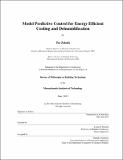Model predictive control for energy efficient cooling and dehumidification
Author(s)
Zakula, Tea
DownloadFull printable version (2.397Mb)
Other Contributors
Massachusetts Institute of Technology. Department of Architecture.
Advisor
Leslie K. Norford.
Terms of use
Metadata
Show full item recordAbstract
Energy has become a primary concern in countries worldwide, and is a focus of debates on national security, climate change, global economy, and the developing world. With more people in developing countries adopting the lifestyle of western countries as rapidly as possible, limited only by economic means, a tremendous increase in world's energy consumption in the next few decades seems difficult to avoid. The building sector is of particular interest, since it accounts for a large portion of the total energy market: currently in the U.S. forty percent of the total energy and seventy percent of electricity is consumed by residential and commercial buildings. Within commercial buildings, cooling equipment represents the second largest consumer of electricity. This research analyzes one option for reducing space cooling energy consumption, an advanced cooling system termed low-lift cooling system (LLCS). The system comprises thermally activated building surfaces (TABS) with water running through pipes embedded in a building's construction to serve both as cool storage and as a means of delivering the cooling effect. The LLCS utilizes model predictive control (MPC) algorithm that, based on weather and load predictions, determines the cooling strategy over next 24 hours that minimizes energy consumption. Different objectives, such as minimizing the total cost of electricity, can be achieved by modifying the objective function. Currently there is no commercially or publicly available software that allows the analysis of systems that employ MPC. The first goal of this research was to develop a computer algorithm that can simulate the LLCS performance, but also the performance of other cooling systems that employ MPC. The second goal was to analyze the LLCS performance across different U.S. climates relative to a conventional cooling system and to explore different dehumidification strategies that can be used in combination with the LLCS. This research significantly advances the knowledge of simulation and performance of the LLCS. The developed MPC algorithm enables a systematic study of primary factors influencing dynamic controls and the savings potential for an individual building. The algorithm is highly modular, enabling easy future expansion, and is sufficiently fast and robust for an implementation real buildings. The results of the analysis suggest that the electricity savings using the LLCS are up to 50% relative to an all-air system under conventional control and up to 23% relative to an all-air system under MPC. The savings were achieved through lower fan and pump transport energy and better utilization of part-load efficiencies inherent in inverter-compressor equipment, a result of the TABS technology and the optimal control.
Description
Thesis (Ph. D. in Building Technology)--Massachusetts Institute of Technology, Dept. of Architecture, 2013. This electronic version was submitted by the student author. The certified thesis is available in the Institute Archives and Special Collections. Cataloged from student-submitted PDF version of thesis. Includes bibliographical references (p. 147-154).
Date issued
2013Department
Massachusetts Institute of Technology. Department of ArchitecturePublisher
Massachusetts Institute of Technology
Keywords
Architecture.